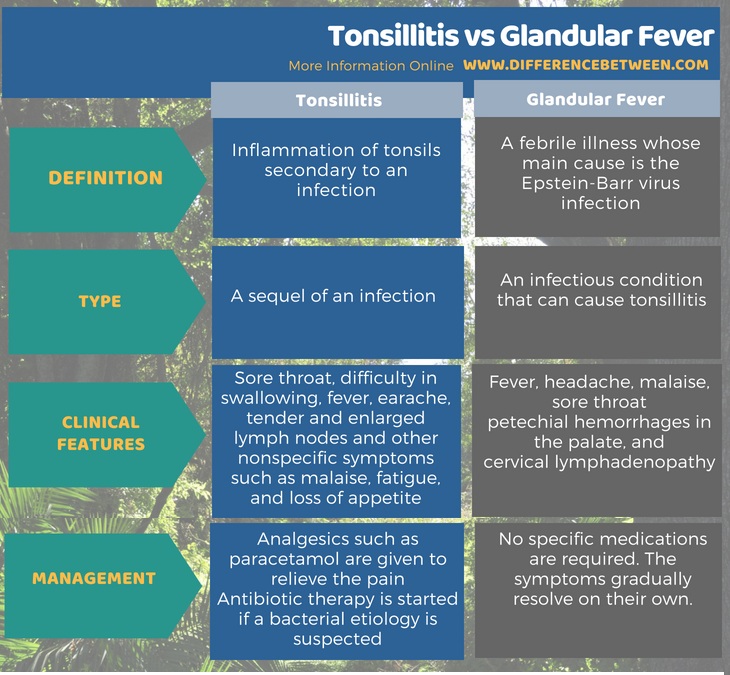Difference Between Tonsillitis and Glandular Fever
The key difference between tonsillitis and glandular fever is that tonsillitis is a sequel to an infection whereas glandular fever is an infectious condition that can cause tonsillitis. That is, tonsillitis is the inflammation of tonsils secondary to an infection, but on the other hand, glandular fever is a febrile illness whose main cause is the Epstein-Barr virus infection.
The throat, or more technically the pharynx, contains a vital group of lymph nodes known as the tonsils. They play a key role in preventing the entry of pathogens into the human body. In most disease conditions, these lymph nodes get affected, giving rise to constitutional symptoms such as fever, sore throat, and malaise.
CONTENTS
1. Overview and Key Difference
2. What is Tonsillitis
3. What is Glandular Fever
4. Similarities Between Tonsillitis and Glandular Fever
5. Side by Side Comparison – Tonsillitis vs Glandular Fever in Tabular Form
6. Summary
What is Tonsillitis?
Tonsils consist of surface epithelium, which is continuous with that of the oral cavity, crypts which are invaginations of the surface epithelium and lymph tissues. The inflammation of tonsils secondary to an infection is known as tonsillitis.
There are four main forms of tonsillitis:
- Acute catarrhal tonsillitis
This mostly occurs due to viral infection as a part of generalized pharyngitis
- Acute follicular tonsillitis
Infection involving the crypts which get filled with pus
- Acute parenchymatous tonsillitis
The tonsilar substance is affected and is characterized by the uniform enlargement of the tonsils.
- Acute membranous tonsillitis
Exudations from the crypts form a membrane on the surface of the tonsils.

Etiology
Commonest causative agents are beta-hemolytic streptococci. Staphylococci, pneumococci, and Hemophilus can also cause tonsillitis.
Clinical Features
- Sore throat
- Difficulty in swallowing
- Fever
- Earache
- Other nonspecific symptoms such as malaise, fatigue, and loss of appetite
- Tender and enlarged lymph nodes
Management
- Bed rest and consuming high amounts of fluids
- Analgesics such as paracetamol to relieve the pain
- Antibiotic therapy
What is Glandular Fever?
Glandular fever (infectious mononucleosis) is a febrile illness caused by the Epstein-Barr virus infection. Adolescents and young adults are the predominantly affected age groups. The spread of the infectious agents happens via saliva.
Clinical Features
- Fever
- Headache
- Malaise
- Sore throat
- Petechial hemorrhages in the palate
- Cervical lymphadenopathy
The symptoms usually last for about 2 weeks.

Diagnosis
The presence of CD8+ lymphocytes in the peripheral blood is strongly suggestive of EBV infection. After the second week from the onset of symptoms, the Paul-Bunnell reaction is used for the confirmation of diagnosis.
Treatment
This condition doesn’t require specific medication. The symptoms gradually resolve on their own. Bed rest and good sleep can expedite the recovery.
What are the Similarities Between Tonsillitis and Glandular Fever?
- Both conditions can cause fever, sore throat and malaise.
What is the Difference Between Tonsillitis and Glandular Fever?
Tonsillitis is the inflammation of tonsils secondary to an infection while glandular fever is a febrile illness whose main cause is the Epstein-Barr virus infection. Most importantly, tonsillitis is a sequel to an infection while glandular fever is an infectious condition that can cause tonsillitis. This is the key difference between tonsillitis and glandular fever.
Further, sore throat, difficulty in swallowing, fever, earache, tender and enlarged lymph nodes and other nonspecific symptoms such as malaise, fatigue, and loss of appetite are the clinical features of tonsillitis. While, clinical features of glandular fever include fever, headache, malaise, sore throat, petechial hemorrhages in the palate, and cervical lymphadenopathy.
In tonsillitis, analgesics such as paracetamol can relieve the pain. Moreover, antibiotic therapy is started if a bacterial etiology is suspected. In contrast, glandular fever doesn’t require any specific medication. The symptoms gradually resolve on their own. Furthermore, bed rest and good sleep can expedite the recovery.

Summary – Tonsillitis vs Glandular Fever
To sum up, tonsillitis is a sequel to an infection while glandular fever is an infectious condition that can cause tonsillitis. This is the main difference between tonsillitis and glandular fever.
Reference:
1. Kumar, Parveen J., and Michael L. Clark. Kumar & Clark clinical medicine. Edinburgh: W.B. Saunders, 2009.
Image Courtesy:
1. “Blausen 0860 Tonsils&Throat Anatomy” By Blausen.com staff (2014). “Medical gallery of Blausen Medical 2014”. WikiJournal of Medicine 1 (2). DOI:10.15347/wjm/2014.010. ISSN 2002-4436. – Own work (CC BY 3.0) via Commons Wikimedia
2. “Amoxycillin rash in infectious mononucleosis on back of hand” By RainbowKatie – Own work (CC BY-SA 3.0) via Commons Wikimedia
ncG1vNJzZmivp6x7pbXFn5yrnZ6YsqOx07CcnqZemLyue8OinZ%2Bdopq7pLGMm5ytr5Wau27AzqeqoqScnsGqv4yapZ1ll6Gur7DUpZirZZaaw6a%2Bjg%3D%3D